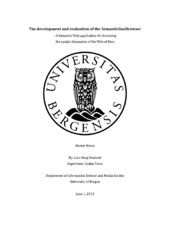The development and evaluation of the SemanticGeoBrowser - A Semantic Web application for browsing the spatial dimension of the Web of Data
Master thesis
Permanent lenke
https://hdl.handle.net/1956/7001Utgivelsesdato
2013-06-01Metadata
Vis full innførselSamlinger
Sammendrag
The Semantic Web is woven together into a Web of data by statements expressed through the Resource Description Framework (RDF) syntax. This syntax only accepts sentences that are shaped by a subject, predicate and object, which is described as a RDF triple. The purpose of creating a RDF triple is to describe a relation between two resources, the subject and object, through the use of a predicate. The syntax enables computers to effectively process RDF data. Plain RDF triples is however not easily read and understood by humans. A common way for humans to browse the Web of data is nevertheless the general web browser, originally designed for browsing the Web of interlinked hypertext documents, created for human consumption. As semantic technologies are being put into practice and the Web of data is growing, the issue of how to browse the Semantic Web has raised on the agenda of the Semantic Web community. The SemanticGeoBrowser is an effort to contribute to the spatial dimension of the Semantic Web. The focus of this design-science research study has been to identify and develop a user-friendly design for browsing geospatial things described in the Web of data. An iterative search and development process has resulted in a proof of concept artifact. This prototype demonstrates a possible solution on how a Semantic Web browser can work. The design artifact was evaluated through a descriptive evaluation method, selected from the design-science knowledge base.
